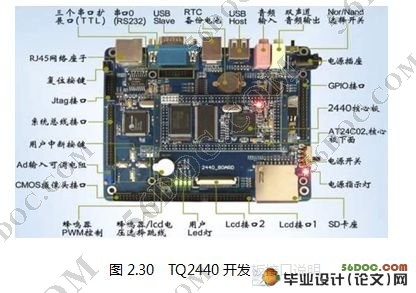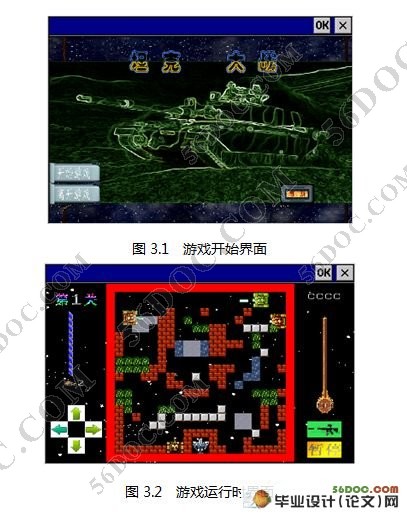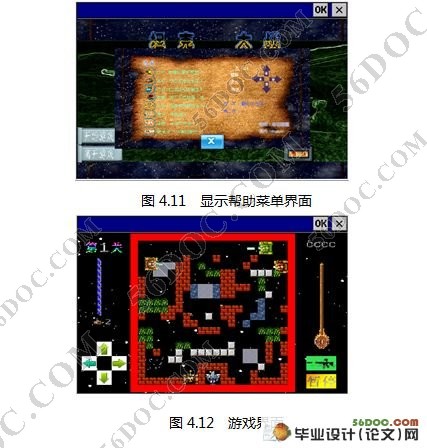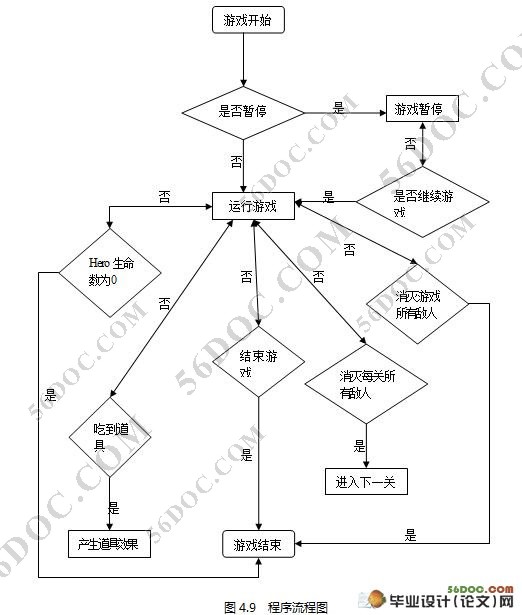基于WindowsCE下的嵌入式坦克游戏的开发(附答辩记录)
无需注册登录,支付后按照提示操作即可获取该资料.
基于WindowsCE下的嵌入式坦克游戏的开发(附答辩记录)(任务书,开题报告,中期检查表,毕业论文27000字,答辩审批表,源程序)
摘 要
本课题的主要任务是在基于ARM9芯片S3C2440的硬件平台TQ2440上,定制Windows CE5.0操作系统,开发一款2D坦克游戏。游戏功能包括吃道具,进入隐藏地图,显示坦克属性,暂停、退出和重新开始游戏等。系统的定制利用 Platform Builder 5.0 来定制Windows CE 5.0操作系统。游戏程序采用Embedded Visual C++ 4.0集成开发环境编写。
本文分几部分阐述了基于Windows CE下的嵌入式坦克游戏的开发过程,分章节较详细的介绍了游戏的结构和设计实现过程,并详细画出了类图、程序流程图及用例图,介绍了各个功能模块相关技术,写出了测试过程及测试结果。
关键词:TQ2440,Windows CE 5.0,Embedded Visual C++ 4.0,2D游戏
ABSTRACT
The main task of this topic is based on unit S3C2440 on the platform ,getting Windows CE5.0 operating system and developing a 2D tank game . The functions of the game include eating props, access to hidden map, show the tank attributes, pause, exit and start the game and so on.The Windows CE 5.0 operating system is made by Platform Builder 5.0. The game is programed by Embedded Visual c + + 4.0 integrated development environment.
This paper divides into several parts to detail introduce embedded tanks game development process which is based on Windows CE platform, and separate several chapters to introduce the structure and detail design process of the game, and show the class diagram and program flow chart and case diagram, introduces related technologies of each functional module, and wroted the testing process and test results.
Keywords: TQ2440, Windows CE 5.0,Embedded Visual C++ 4.0,2D game
游戏的整个过程都通过触摸屏的触控动作来完成。游戏开始时,可以通过点击帮助按钮打开游戏帮助菜单,游戏过程中当按住某个方向键不松开时,坦克就会延着这一方向连续移动。并能发射子弹,还能够暂停游戏,返回游戏等。本游戏的操作简单,方便。对设备的配置要求也不高,适应性强。
软件环境
Embedded Visual C++ Embedded Visual C++ 4.0 Windows CE Platform Builder 5.0




#p#副标题#e#
目 录
摘 要 I
ABSTRACT II
第1章 绪论 1
1.1嵌入式系统的介绍 1
1.1.1 嵌入式系统的定义 1
1.1.2 嵌入式系统的组成 1
1.2 嵌入式系统的现状和发展趋势 2
第2章 开发环境介绍 4
2.1 软件环境 4
2.1.1 Embedded Visual C++的介绍 4
2.1.2 Embedded Visual C++ 4.0的安装 4
2.1.3 Windows CE的介绍 7
2.1.4 Platform Builder 5.0的安装 8
2.2系统定制 11
2.2.1 BSP包的安装 11
2.2.2 Windows CE操作系统的编译 12
2.3硬件环境 14
2.3.1 TQ2440开发板说明 14
2.3.2 TQ2440开发板核心部件 16
2.3.3 系统的移植 17
2.3.4 应用程序在开发板上运行的方法 18
第3章 系统分析 19
3.1 模块需求分析 19
3.1.1 游戏界面 19
3.1.2 游戏逻辑分析 20
3.1.3 游戏操作 21
3.2 系统可行性分析 21
第4章 系统设计 22
4.1 类的设计 22
4.2 UML类图 23
4.3 游戏程序流程图 30
4.4 游戏具体代码实现 31
4.4.1 游戏界面 31
4.4.2 地图的实现 34
4.4.3 游戏的初始化 37
4.4.4 重绘游戏区 38
4.4.5 碰撞检测 39
第5章 系统测试 42
5.1 软件测试的概述 42
5.2 软件测试的目的和原则 42
5.2.1 软件测试的目的 42
5.2.2 软件测试的原则 43
5.3 软件测试的过程 44
5.3.1 需求分析 44
5.3.2 测试计划 44
5.3.3 测试设计 45
5.3.4 测试环境搭建 46
5.3.5 测试执行 46
5.4 软件测试的方法 47
5.4.1 白盒测试 47
5.4.2 黑盒测试 48
5.5 坦克游戏系统测试 48
结 论 50
参考文献 51
附 录 游戏关键代码 52
致 谢 63
